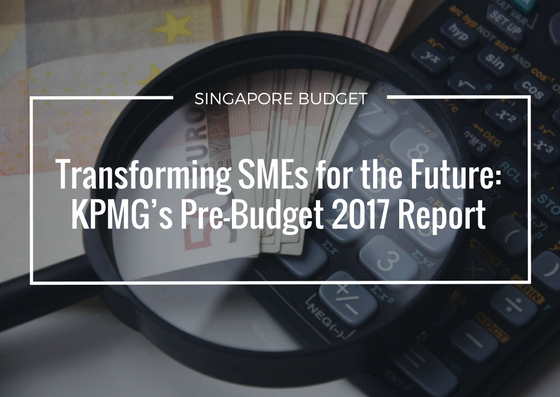
Transforming SMEs for the Future: KPMG’s Singapore Pre-Budget 2017 Report
KPMG has released a pre-Budget 2017 report that examines what Singapore companies are doing in the current uncertain economic outlook and what may be done to assist them into the future. The report aims to provide insights and feedback for the Committee for the Future Economy for Budget 2017. Below summarizes the report findings.
Observations – Pre-Budget 2017
The cause of uncertain economic outlook can be attributed to several factors:
- Political tensions between China and South-east Asia
- Deglobalisation messages such as Brexit and US President Donald Trump’s protectionism
- Bank’s tighter credit approval processes
- Rising operational cost resulting from increasing rental and manpower cost, especially on SMEs
- General lack of specialised talent, mismatch of jobs and skills
Despite the gloomy outlook, many companies are optimistic and forward looking, preparing for a turnaround in 2018 with long-term growth plans:
- Developing technology and innovation
- Internationalising into new markets
These long-term growth plans are not without concerns, especially for SMEs:
- Difficulty in integrating technology into business while facing short-term business pressures
- Lack of know-how in technology and foreign market regulations
Proposals for the Committee for the Future Economy and Government
The proposals can be grouped under three pillars:
1. Supporting firms in downturn
2. Embracing disruption, boosting innovation
3. Encouraging internationalisation, entrepreneurship
1. Supporting firms in downturn
- Productivity and Innovation Credit (PIC) is one of the most generous and easier to apply schemes that helped SMEs upgrade their technological capabilities. This should be continued or even further incentivise to help mitigate rising cost
- Increasing labor and operating cost may be indirectly address by deferring increase in workers levies while extending Wage Credit Scheme so as to maintain a skilled workforce
- Cost mitigation can also be done by providing rental rebates and/or freeze current Government fees and charges
2. Embracing disruption, boosting innovation
Digital disruption is a challenge for SMEs, but also a source of growth. SMEs need guidance in incorporating technology to transform business and subsidies for the large upfront capital in order to implement these changes
- Policies to accelerate and incentivise digital transformation of business such as tax reduction for IT roles and flexibility to employ foreign manpower with IT skills are encouraged
- R&D is crucial in building a sustainable competitive advantage for continued economic growth; policies such as Innovation Tax Credit and other incentives should be implemented to spur innovation, as well as support for SMEs
- More can be done to facilitate SMEs in developing their brands on the global stage to stay relevant and value-add the economy
3. Encouraging internationalisation and entrepreneurship
Internationalisation is needed so that SMEs can ride on the regional dynamic growth. However, as mentioned, SMEs require various support in their development plans
- Larger grants for overseas market studies, introducing International Expansion Acceleration Programme and accrediting consultants to help SME venture overseas are encouraged
- Grants to help SMEs take understand and take advantage of Free Trade Agreements (FTA) may help them capitalise on these opportunities through partnership/guidance with larger enterprises
- Increase tax reduction for individual investors such as angel investors to support new, radical ideas
Conclusion – Budget 2017
All in all, the gloomy economic outlook has challenged SMEs and larger enterprises in rising cost, disruptive technology and the need for internationalisation. The proposals by KPMG are aimed to help SMEs reduce operational cost and increase grants so that the above challenges can be met by the ill-resourced SMEs. Tighter lending by banks increased the cost of financing for SMEs.
InvoiceInterchange stands ready to help SMEs tackle the challenges by providing a low cost of financing through invoice trading. These capital locked in the supply chain can be utilized to develop and integrate technology into the business, mitigate operational cost and even finance the cost required for venturing into new markets. Free up the locked cash by invoice trading to obtain payment much earlier now!
Related Articles

Top Strategies to Help You Manage Late Payment Effectively

Balancing Cash Inflow and Outflow: Essential Strategies for Your Business
